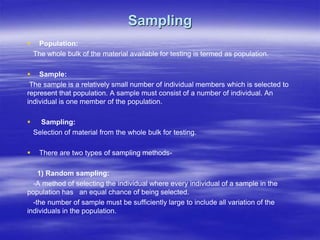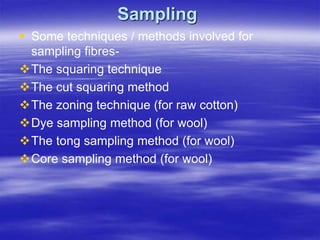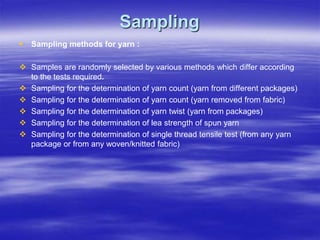Textile Testing and Quality Control
- 1. Sampling ’é¦ Population: The whole bulk of the material available for testing is termed as population. ’é¦ Sample: The sample is a relatively small number of individual members which is selected to represent that population. A sample must consist of a number of individual. An individual is one member of the population. ’é¦ Sampling: Selection of material from the whole bulk for testing. ’é¦ There are two types of sampling methods- 1) Random sampling: -A method of selecting the individual where every individual of a sample in the population has an equal chance of being selected. -the number of sample must be sufficiently large to include all variation of the individuals in the population.
- 2. Sampling 2) Biased sampling method: ’üČ In biased sampling method, the selection of an individual is influenced by factors other than chance. ’üČ Hence the sample does not truly represent the bulk. ’üČ Depending on the position of the sampling person. ’é¦ Factors affecting sampling methods: ’üČ The form of the material ’üČ Amount of material available ’üČ Nature of the test ’üČ Type of testing instrument ’üČ Information required ’üČ Degree of accuracy required
- 3. Sampling ’é¦ Sampling methods for different textile materials: ’üČ Sampling for the determination of fiber properties ’üČ Sampling methods for yarn ’üČ Sampling methods for fabric ’é¦ Sampling for the determination of fibre properties: ’üČ It depends upon the form in which the fibre is available. Different techniques for different form of fibres- ’üČ Fibres in bale ’üČ Fibres in sliver ’üČ Fibres in yarn etc
- 4. Sampling ’é¦ Some techniques / methods involved for sampling fibres- ’üČThe squaring technique ’üČThe cut squaring method ’üČThe zoning technique (for raw cotton) ’üČDye sampling method (for wool) ’üČThe tong sampling method (for wool) ’üČCore sampling method (for wool)
- 5. Sampling ’é¦ Sampling methods for yarn : ’üČ Samples are randomly selected by various methods which differ according to the tests required. ’üČ Sampling for the determination of yarn count (yarn from different packages) ’üČ Sampling for the determination of yarn count (yarn removed from fabric) ’üČ Sampling for the determination of yarn twist (yarn from packages) ’üČ Sampling for the determination of lea strength of spun yarn ’üČ Sampling for the determination of single thread tensile test (from any yarn package or from any woven/knitted fabric)
- 6. Sampling ’é¦ Sampling methods for fabric : ’é¦ Points of consideration while sampling fabric: ’üČ Fabric within 2 inches of the selvedge should not be used. (Tension variation/strain on the yarns has effects)No two samples should contain the same threads ’üČ Form (narrow/wide) & amount of fabric available for testing






